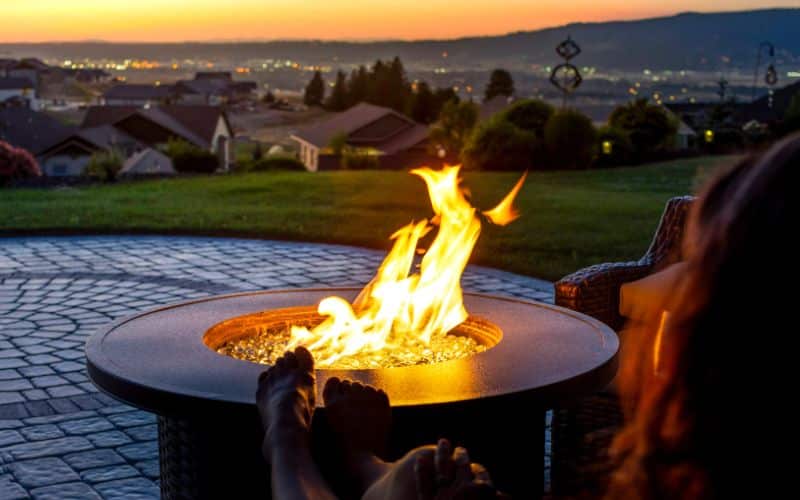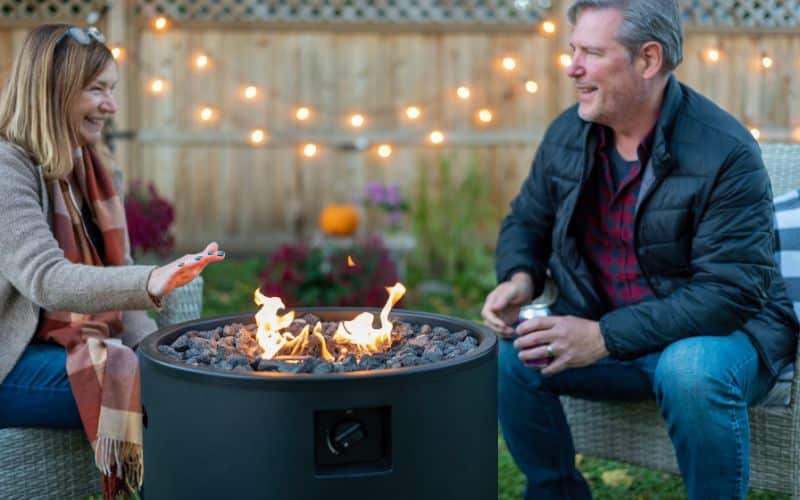
If you’ve ever wondered how a smokeless firepit works, you’re not alone. This ingenious invention has been making waves in the outdoor living world for its ability to provide all the warmth and ambience of a traditional firepit, without the annoying smoke. So, what’s the secret behind this marvel? Let’s dive right into it.
A smokeless firepit operates on an advanced system known as ‘secondary combustion’. This term might sound complicated but it’s actually quite simple when broken down. The process involves two key steps: primary and secondary burning stages.
In the primary stage, wood or other fuel is burned in a lower chamber similar to any regular pit; however, that’s where similarities end. In addition to this primary burn area there exists another one – a secondary burn chamber where magic happens! Here, fresh air is drawn up through vents causing leftover particles from initial combustion to reignite resulting in more heat with less smoke produced.
It’s truly fascinating isn’t it? By embracing science and technology we can enjoy our fireside gatherings without having teary eyes or smelling like campfire for days after!

Understanding Smokeless Firepit Technology
You’re probably wondering, how does a smokeless fire pit work? Well, it’s all about the technology that goes into making these innovative outdoor accessories. The primary technology behind smokeless fire pits is what’s known as ‘secondary combustion’. This means that the fire pit burns not only the initial fuel (like wood or charcoal) but also any remaining particles and gases – typically smoke – produced by this first burn.
Think of it like this: when you light a traditional fire pit, there are two stages to burning. The first is where your fuel (usually wood or charcoal) catches alight and starts to break down due to heat. During this process, unburned particles and gases escape upwards in the form of smoky plumes.
In contrast with traditional models, a well-designed smokeless firepit utilises clever engineering to push excess heat from below back up through strategically placed vents towards those escaping particles and gases. When they meet at high temperatures – we’re talking around 600°C here! – those would-be pollutants combust again instead of wafting away as annoyingly pungent fumes.
To give you an idea:
- A conventional campfire temperature reaches around 200-300°C
- Wood gasification happens between 500-600°C
- A well-engineered smokeless pit achieves these higher temps!
And there lies your answer! It’s through this double-burning action that you get significantly lessened levels of irritating lung-clogging pollution compared with regular alternatives. And let’s face it; nobody enjoys their clothes reeking like an ashtray after a pleasant evening outdoors!
Smoke-free doesn’t mean experience-free either! In fact, many users find them even more enjoyable than old-school counterparts because they deliver consistent radiant warmth without pesky embers flying off unpredictably which can pose safety risks too.
Of course every design varies slightly but now you’ve got a handle on the basics. Next time you’re gathered round your smokeless firepit, impress your friends with this hot knowledge! You’ll be sparking interesting conversations before the marshmallows even come out!
Components of a Smokeless Firepit
Delving into the world of smokeless firepits, you’ll discover they’re composed of several key components. All these elements work together to reduce the amount of smoke produced during burning.
Firstly, there’s the double-wall construction. This feature is vital in most high-quality smokeless fire pits. The design works by drawing in cold air from underneath and warming it as it travels up between the walls. The heated air then gets released through small holes near the top, promoting better combustion that results in less smoke.
Next on our list is an insulated inner bowl or burn chamber where your fuel – usually wood pellets or logs – goes to burn away merrily. This part is often made from stainless steel for durability and heat resistance.
Then we’ve got a mesh screen or spark guard that sits atop your pit. It serves two purposes: firstly, it stops any embers escaping upwards; secondly, it helps distribute heat evenly around your gathering space while keeping you safe from flying sparks.
The base or stand plays its own role too! It lifts your fire pit off ground level ensuring improved airflow which contributes towards efficient combustion and thus reduces smoke production further still.
Finally, some models incorporate a vent system designed specifically to maximise airflow throughout all stages of burning – again with aim being minimising that pesky clouding effect so many other fires produce!
- Double-wall construction
- Insulated inner bowl/burn chamber
- Mesh screen/spark guard
- Base/stand
- Vent system

Benefits and Drawbacks of Using a Smokeless Firepit
You’re probably curious about the upsides and downsides of using a smokeless firepit. Let’s dive in to explore both angles, so you can make an informed decision.
The benefits are numerous:
- First off, it’s all in the name – smokeless. You’ll no longer have to play musical chairs around your fire pit trying to avoid choking on heavy plumes of smoke.
- Secondly, they offer efficient fuel consumption. These firepits are designed with secondary combustion systems that allow for more complete burning of wood. This means you’ll need less fuel for your fires.
- Lastly, they provide a safer environment as compared to traditional ones due their design which reduces sparks and minimises ash production.
Despite these advantages though, there are some drawbacks:
- One major downside is cost; these models often come with higher price tags than their conventional counterparts.
- While it’s true that they burn wood more efficiently, they can also be fussier about what kind of wood you use—hardwoods work best while softer woods may not generate enough heat or last long enough.
Just like any product out there on the market today, smokeless fire pits have their pros and cons. It’s important to weigh up these factors against your needs before making a purchase decision.
Concluding Thoughts on How a Smokeless Firepit Works
After diving deep into the mechanics of smokeless firepits, you’ve likely gained an appreciation for their clever design and functionality. These innovative outdoor features harness advanced technology to provide you with a cleaner, more enjoyable open-air experience.
Firstly, it’s all about airflow in these nifty contraptions. A double-wall construction funnels air from below and feeds it to the flames above. This process supercharges combustion ensuring that your fire burns hotter and brighter while producing significantly less smoke.
Secondly, we can’t overlook the secondary burn created by this type of firepit. Hot air drawn up through the walls gets reignited at higher temperatures leading to almost complete combustion of fuel before any potential for smoke generation occurs.
Here are some key takeaways:
- Double-wall construction enhances airflow
- Supercharged combustion leads to less smoke production
- Secondary burn reduces residual unburnt particles
Smokeless doesn’t mean absolutely no emissions though; remember there will still be some level of particulates released into your environment but in much smaller amounts compared with traditional bonfires or wood-burning stoves.
So now you’re well-versed in how a smokeless firepit works! It’s not magic but simply science making those summer nights spent around a roaring campfire even better than before without choking on clouds of unpleasant thick fumes.







